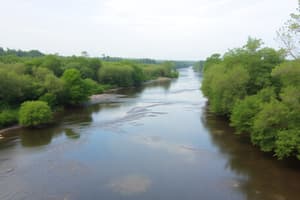Podcast
Questions and Answers
What is the main purpose of river restoration?
What is the main purpose of river restoration?
- To restore a functioning river system to support native biodiversity and key ecosystem services (correct)
- To increase industrial waste in rivers
- To reduce agricultural runoff in rivers
- To speed up the process of river pollution
Why are floodplains important in mitigating flood risk?
Why are floodplains important in mitigating flood risk?
- Because they absorb excess water during floods (correct)
- To accelerate the flooding process
- To increase the risk of floods
- To reduce wetland areas
How can pollution impact rivers?
How can pollution impact rivers?
- By having no effect on aquatic ecosystems
- By increasing the overall health of rivers
- By enhancing aquatic species diversity
- By adversely affecting aquatic species and ecosystems (correct)
What is the significance of river morphology in river restoration?
What is the significance of river morphology in river restoration?
Which directive is supported by river restoration efforts?
Which directive is supported by river restoration efforts?
Why do rivers play a vital role in supporting diverse ecosystems?
Why do rivers play a vital role in supporting diverse ecosystems?
What factors influence river ecosystems?
What factors influence river ecosystems?
Which of the following activities can cause morphological changes in rivers?
Which of the following activities can cause morphological changes in rivers?
What is the significance of understanding river morphology?
What is the significance of understanding river morphology?
Which natural process can have significant impacts on river ecosystems?
Which natural process can have significant impacts on river ecosystems?
What are some key functions of river ecosystems?
What are some key functions of river ecosystems?
Which human activities pose challenges to river ecosystems?
Which human activities pose challenges to river ecosystems?
Flashcards are hidden until you start studying
Study Notes
Rivers: An Overview of Ecosystems, Morphology, Flooding, Pollution, and Restoration
Rivers are dynamic ecosystems that provide various ecological, hydromorphological, and socio-economic services. They are integral to the functioning of river basin management while supporting native biodiversity and key ecosystem services. This article explores the subtopics of river ecosystems, river morphology, river flooding, river pollution, and river restoration, focusing on their significance and challenges.
River Ecosystems
River ecosystems are diverse and complex, consisting of various biotic and abiotic components. These ecosystems are influenced by factors such as water quality, temperature, and sediment deposition. The ecological functions of rivers include supporting aquatic and riparian species, maintaining water quality, and contributing to the overall health of riverine systems.
River Morphology
River morphology refers to the physical structure and characteristics of a river, including its bed, banks, and floodplain. Morphological changes in rivers can occur naturally or as a result of human activities such as dams, river training, flood embankments, water abstraction, dredging, and sediment mining. Understanding river morphology is essential for effective river restoration and management.
River Flooding
Flooding is a natural process that can have significant impacts on river ecosystems. Floodplains play a crucial role in mitigating flood risk and maintaining ecosystem services. Restoring natural features and processes to rivers, such as floodplains and wetlands, can help combat floods and droughts.
River Pollution
River pollution is a significant problem worldwide, with sources including industrial waste, agricultural runoff, and municipal sewage. Pollution can have adverse effects on aquatic species and ecosystems, affecting the overall health of rivers and the services they provide.
River Restoration
River restoration is the process of restoring a functioning river system to support native biodiversity and key ecosystem services. This can involve ecological, hydromorphological, physical, spatial, and management measures and practices. River restoration is an integral part of river basin management and supports the objectives of the Water Framework Directive (WFD), Habitats Directive (HD), Floods Directive, and the EU Biodiversity Strategy for 2030.
In conclusion, rivers play a vital role in supporting diverse ecosystems and providing essential services to human societies. Understanding the subtopics of river ecosystems, morphology, flooding, pollution, and restoration is crucial for effective river management and conservation. By addressing these challenges, we can ensure the long-term sustainability of our rivers and the benefits they provide.
Studying That Suits You
Use AI to generate personalized quizzes and flashcards to suit your learning preferences.




